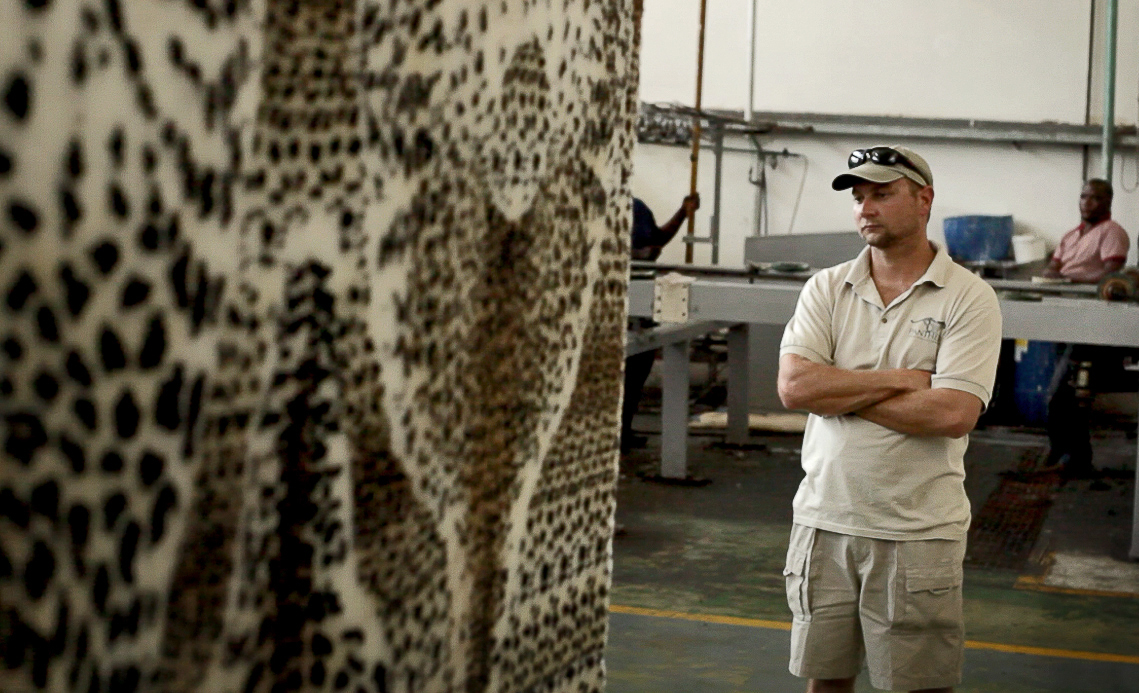At first glance, the scene at the Nazareth Baptist Church’s annual July pilgrimage at eBuhleni in KZN is a big cat conservationist’s nightmare. Thousands of beautiful rosettes dance with the rhythm of chanting Shembe men, from what appear to be the skins of hundreds of slaughtered leopards draped across shoulders. But believe it or not, this year’s pilgrimage is a mark of one of the greatest conservation achievements in the past decade.

In 2010, global big cat conservation group Panthera set out on a mission to save the scores of leopards which were being illegally hunted for their skins by members of the four-million strong Shembe religion, for use in ceremonial dress. Traditionally, leopard skins are like Ferraris for Shembe men – the ultimate symbol of power and status, selling for up to R6000 a pop.
Under the leadership of Furs for Life Leopard Program manager Tristan Dickerson, Panthera used 3D imaging and photography to create a synthetic leopard skin that could barely be told apart from the real thing. When khuluma first covered the Furs for Life project in 2013, only 50 of these skins had been accepted by the church, who were understandably reluctant to depart from a tradition that stretches back centuries.
Three years and an enormous amount of hard work later, half of the dancing rosettes you see at the eBuhleni pilgrimage (which is attended by tens of thousands of church members every year) belong to replica skins. With financial backing from the Peace Parks Foundation and Cartier, 13 800 skins have been manufactured and distributed to the church, more than triple the entire estimated leopard population of South Africa.
“In 2016, the ratio of real versus synthetic skins fell to 1.3:1, compared to 8:1 in 2014. If you had asked us whether we expected to achieve this kind of success at the beginning we would have been hopeful, but called it a pretty ambitious dream,” says Dickerson.
Along the way, Panthera has fought to change established Shembe beliefs, such as the assumption that Shembe founder Isaiah Shember has supernatural powers he uses to make more leopards.
After initial disdain and even hostility, the organisation has effectively relayed the message that South Africa’s leopards are a finite resource, numbering around 4 000 individuals increasingly under threat from activities such as the illegal hunting carried out by the Shembe.
“The challenge has been to formalise a way where we can preserve tradition, culture and religion whilst conserving leopards. Through a lot of consultation and education, the Shembe church has become very conscious of this, and are even distributing the skins for us at gatherings now,” Dickerson says.
Shembe elder and legal advisor Lizwi Ncwane said the church had worked closely with Panthera to ensure the replica skins were realistic enough to appeal to the church.
“We are very happy with the quality of the skins and they match the real thing almost exactly. This has been a crucial part of our members accepting these skins,” Ncwane says.

Willingness to accept the faux furs has also been driven by their low price tag. The skins sell for a few hundred bucks, and are more durable too, lasting for many years longer than the quickly moulting and fading real skins.
“It is also far easier and more accessible than hunting a leopard. Besides this, our members are realising that owning the real skins comes with legal difficulties. The church is in a learning process about the conservation status of leopards and we want to ensure that an animal which is so respected by the church doesn’t become extinct,” Ncwane explains.
Panthera has gained some high profile support in the form of Zulu Prince Mangasothu Buthelezi, who has publicly endorsed the project. But the organisation’s work isn’t over yet. Another 4 200 skins will be distributed by the end of 2017, bringing the grand total to 18 000.
“We’ve made huge strides and have also been approached by other religions now who use leopard skin in certain regalia and want to rather use fake fur. We don’t want to divulge too much at this stage, but it’s very encouraging to see this type of progress being made,” Dickerson says.

To Skin a Cat
Documentary film-makers Colwyn Thomas and Greg Lomas have followed Tristan Dickerson on his incredible journey to create the perfect replica leopard skin and halt the decline of South Africa’s leopard population.
To Skin a Cat offers a deep insight into Dickerson’s trials, tribulations and successes, as the conservationist seeks to balance age-old heritage with the conservation of one of Africa’s most iconic animals.
The documentary premiered to sell out crowds in Durban, Johannesburg and Cape Town and is currently being adapted for airing on TV channels such as National Geographic. To view the trailer, visit www.toskinacat.org. To help Panthera with their work of protecting wild cats and their habitats, go to www.panthera.org/donate.
*This article was written by a TWNA journalist, Dale Hes for Kuluma Airline magazines.